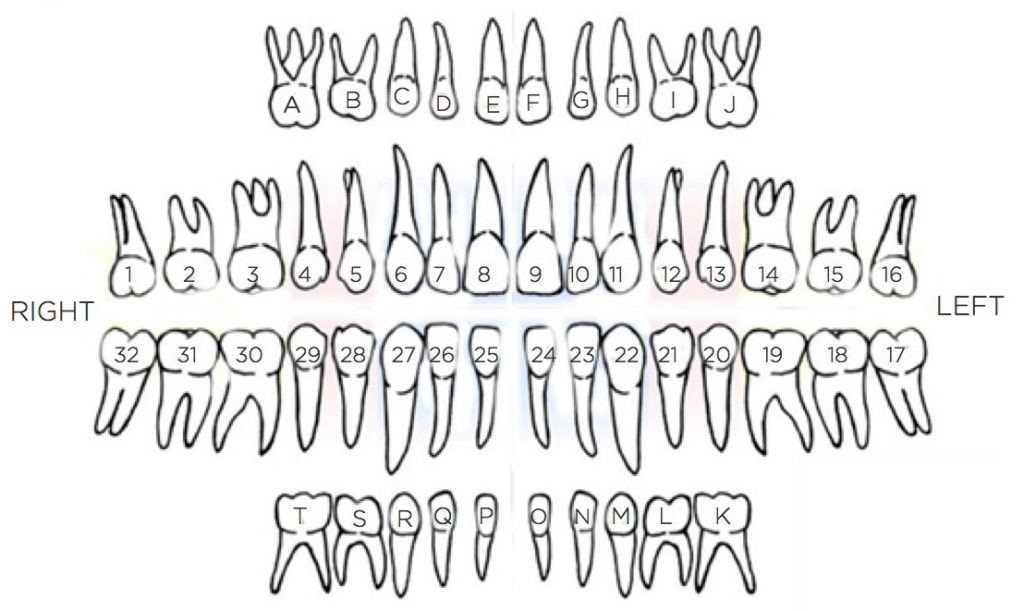
Making Sense Of The Tooth Number and Letter Chart
Have you ever been to the dentist and overheard a dental hygienist or dental assistant talk to the dentist using different numbers or letters? They are most likely referring to your teeth on the tooth number or letter chart. This chart identifies each tooth in the mouth with a specific number for adult teeth or letter for baby teeth. Identifying each tooth in such a way can be helpful when taking care of your teeth or identifying any problems with a particular tooth. Familiarizing yourself with the tooth numbering and lettering system can be helpful if you want to learn more about your teeth. We will review everything that you need to know so that the next time you hear someone talking about a tooth’s number or letter, you too will know which tooth they are referring to.
Tooth Lettering For Baby Teeth
Top teeth for babies begin on your right-hand side with the letter A. There are 10 upper baby teeth in total. The last upper baby tooth is labeled with the letter J. Bottom teeth for babies begin on the right-hand side with the letter T and end with the letter K. Your child’s permanent teeth will begin to come in at age 5-6. At that point, the tooth lettering system becomes a numbering system for your little one’s permanent teeth. We will now review the tooth numbering system for permanent teeth.

Maxillary And Mandibular Arches (Permanent Teeth)
Your top teeth, which are numbered 1-16 form the maxillary arch. The numbering of these top teeth begins at your right rear wisdom tooth (right-hand side). Therefore, your 3rd molar, or right rear wisdom tooth would be tooth number one.
Teeth 17-32 are the bottom teeth and they are referred to as the mandibular arch. The numbering for these lower teeth begin with the rear wisdom tooth (left-hand side). Therefore, your 3rd molar, or left rear wisdom tooth, would be tooth number 17.
Anterior And Posterior (Permanent Teeth)
Now that we have established numbering for the top and bottom teeth, we will review the specific numbering for the front teeth (incisors) and back teeth (molars). The front teeth, or anterior teeth are numbered 6-11 in the top of the mouth and 22-17 in the bottom of the mouth. The posterior or back teeth have 4 sections. They are 1-5 and 12-16 in the top of the mouth and 17-21 and 28-32 in the bottom of the mouth.
The Importance of Tooth Identification
Tooth numbering and lettering is important to both patients and dentists. Dentists use the tooth identification charts to better understand which teeth need a specific treatment. The chart is also used as a record of your dental health for review during future visits. The tooth number and letter chart can be used as a tool to teach children to care for their teeth and identify cavities.
Tooth Identification As Designated By ADA
Incisors are used for biting into food. Incisors are primary teeth D, E, F, G, N, O, P, Q and permanent teeth numbers 7, 8, 9, 10, 23, 24, 25 and 26.
Canines are used for ripping and tearing food apart. Canine teeth are primary teeth C, H, M, R and permanent teeth numbers 6, 11, 22, and 27.
Premolars are used for chewing and grinding food. Premolars are permanent teeth numbers 4, 5, 12, 13, 20, 21, 28 and 29 – there are no primary premolars!
Molars are also used for chewing and grinding food Molars are primary teeth A, B, I, L, S, T and permanent teeth numbers 1, 2, 3, 14, 15, 16, 17, 18, 19, 30, 31, and 32.
Conclusion
A universal tooth numbering system was first proposed in the year 1881 by German dentist Julius Parreidt. Dentists have long known the importance of such a uniform system. The tooth numbering and lettering system we reviewed are accepted and approved by the American Dental Association. It is the most common naming system used by dental professionals in America.
